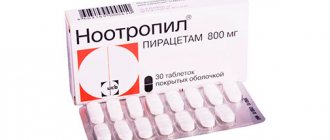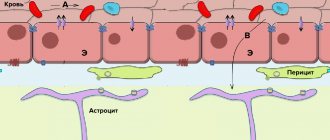Symptoms of a panic attack
The 21st century is rightly called the century of anxiety due to rapidly advancing progress and the acceleration of the rhythm of life. About 7% of the world's population suffers from panic attacks, and this figure is inexorably growing day after day. Suffering people lose social activity, ability to work and fall out of their usual social circle - the disease leaves a huge imprint on a person’s entire life activity. It is extremely important to start treating panic attacks in Moscow at an early stage of the disease.
A panic attack is a combination of mental and physiological manifestations: a vivid attack of anxiety - pointless fear - is accompanied by intense manifestations of the autonomic nervous system. To designate this severe and painful condition, terms such as “vegetative crisis”, “sympathoadrenal crisis”, “vegetative-vascular dystonia”, “vegetative paroxysm”, “neurocirculatory dystonia” are also used.
In the International Classification of Diseases, the latest, tenth revision, panic attack as episodic paroxysmal anxiety is listed in section F41.0. Panic disorder associated with agoraphobia is described in the section. F 40.0.
A panic attack has the following symptoms:
- sudden increase in heart rate, uncomfortable sensations in the heart area;
- lump in the throat, feeling of lack of air, inability to exhale fully;
- panic fear of death;
- inability to sit in one place, fussiness of movements, desire to run away or state of stupor;
- fear of going crazy, losing control of yourself;
- a sharp jump in pressure up or down;
- dizziness, unsteadiness of gait;
- tremor of the limbs and/or trembling throughout the body;
- nausea, discomfort in the stomach;
- the urge to defecate or urinate;
- blurred vision, a feeling of unreality of what is happening.
Interesting! According to scientific research, every 3 people experienced a panic attack at least once in their life, and then happily forgot about it. If attacks occur on a regular basis for more than three weeks, then we are talking about panic disorder, which requires treatment under the supervision of a specialist.
COMPLEX PHYSIOTHERAPY
Physiotherapy includes a set of procedures: laser therapy, magnetic therapy, color rhythm therapy.
In modern neurological practice, this combination of physiotherapeutic methods is considered the gold standard for the treatment of panic attacks and VSD. We constantly monitor the parameters of physiotherapeutic influence (frequency, intensity, duration of influence), based on a detailed analysis of dynamic changes in the state of the autonomic nervous system.
Physiotherapy promotes the regeneration of damaged nerve cells and restoration of normal functioning of the autonomic nerve nodes. It is the most physiological and has no side effects.
Find out more about holistic physiotherapy
Diagnosis of the disease
During a comprehensive examination of the patient, it is necessary to find out whether panic attacks are an independent disease or a symptom accompanying other psychological and/or physiological dysfunctions in the body:
- Isolated panic disorder without a history of other symptoms is treated by stopping attacks and preventing them.
- If panic attacks are a consequence of another underlying disease - they occur against its background, then therapy will be aimed primarily at the identified cause.
For example, if the primary diagnosis is a depressive disorder, and panic attacks are just its consequence, then the doctor will direct all his efforts to eliminate depression. After this, acute anxiety crises go away on their own.
It is almost impossible for the average person to understand this on their own. That is why, if you notice the symptoms described above, you should immediately seek help from a qualified specialist who will tell you in detail about your condition and prescribe appropriate treatment for panic attacks.
How does a panic attack occur?
Almost all patients indicate that a panic attack occurs like a bolt from the blue. The surprise factor leaves its mark on what is happening and is an additional reason for the phobia.
The attack lasts from several minutes to half an hour. During this time, the characteristic symptoms follow the path of a wave: it gradually increases, reaches the extreme point (peak), and then slowly declines. After an attack, a person feels overwhelmed, lethargic, exhausted, and wants to sleep. This is due to the loss of a large amount of energy during a crisis. The frequency of attacks varies from several times a day to several crises per month.
What happens in the body during a vegetative crisis in stages:
- as a result of stress (a situation that a person consciously or unconsciously assesses as threatening), a large dose of stress hormones - adrenaline, norepinephrine, cortisol and prolactin - enters the blood;
- The stress hormone provokes a sharp constriction of blood vessels, which leads to an increase in blood pressure;
- tachycardia – increased heart rate;
- breathing becomes frequent and shallow;
- the concentration of carbon dioxide in the lungs and blood decreases, resulting in dizziness and numbness of the limbs.
Feelings of anxiety, in turn, are an additional factor that enhances the initial reaction to stress. Thus the circle is closed. The higher the intensity of anxiety, the brighter the vegetative manifestations.
Having encountered this phenomenon a couple of times, a person begins to worry about his health, suspecting a serious illness. Fear of an unpleasant condition appears, avoidant behavior develops in exciting situations and “dangerous” places where attacks occurred, and refusal to travel by public and personal transport. As a rule, over time this leads to the fact that going outside becomes impossible. Also, a person suffering from panic attacks always needs the presence of a loved one, since loneliness can subjectively worsen his condition.
The severity of symptoms may vary from person to person: those who experience sensations of high intensity are more likely to seek help. Moderate and mild panic attacks often give a person the illusion of being able to manage and control their condition.
Agoraphobia (agora - square) - fear of open spaces, manifests itself in the fear of going outside, and becomes a consequence of panic disorder.
24/7 CONSULTATION BY PHONE: +7
Symptoms of Autism
For some children, the first manifestations of autism appear in the first years of life. It manifests itself most clearly at 3 years of age. How this disease will manifest itself directly depends on the intellectual development and age of the child. The presence of autism is indicated by the following changes in the child’s behavior:
- Difficulties in communication:
- Speech is developed, but the child cannot speak with strangers;
- The child repeats identical, previously heard phrases that have nothing to do with what is happening;
- Lack of speech, the same facial expression, lack of gestures;
- When talking, the child avoids eye contact and does not smile;
- Incoherent speech, jumps in intonation, rhythm;
- Problems with imagination, resulting in lack of interests;
- Prefers to be alone, withdrawn into oneself;
- Constantly holds the same toy in his hands;
- Excessive irritability;
- When changing the familiar environment, hysterical behavior is characteristic;
- The same actions are repeated all the time;
- Always focused on one thing;
- Problems with socialization;
- Ignores any attempts to communicate, including close people;
- They don’t tell their parents about their problems;
- Do not react to facial expressions and gestures of other people, or unconsciously repeat after them;
- Children do not want to communicate and make friends with their peers;
Autism in a child over 11 years old Children can already communicate with others, but there are still other symptoms of autism:
- Preference to stay in a deserted room;
- All attention is concentrated on the same toy, cartoon, etc.;
- Lack of attention;
- Pointless movements;
- Creating your own strange rules and strictly following them;
- Unfounded fears and anxieties;
- Overly active behavior;
- Panic attacks when changing the usual environment;
- When doing something, a clear sequence is always followed;
- Aggression towards oneself.
Symptoms of the disease at the ages of 2 to 11 years Children with autism at this age are characterized by everything described above, but there are several more signs:
- The child knows few words or does not speak at all;
- The child repeats only one word and does not make contact;
- Difficulties in mastering anything (reading, writing, etc.);
- Sometimes a child develops a passion for a particular subject at school, such as math or reading.
Signs of early childhood autism up to 2 years of age You can often notice the presence of autism in a child already in the first years of his life:
- The baby doesn't smile;
- Not attached to mom. For example, she does not cry when she is not around, does not show initiative when being picked up;
- The baby does not look into the eyes or face;
- Excessive irritability, for example, when the light is turned on or small sounds, the baby begins to cry;
- Constantly reaches for one toy;
- Problems with speech development. The child does not make any sounds or pronounce simple words.
Such symptoms do not indicate one hundred percent presence of autism in the baby. But it is better to discuss the child’s isolation and other symptoms with a specialist.
Panic attacks: drug treatment
The procedure of the pharmacological approach in the treatment of panic disorders can be divided into two stages:
- Relief of an attack - the patient is prescribed tranquilizers of the benzodiazepine group (tablets or injections). Their main difference is the fast-acting effect - within 10-15 minutes after taking the drug, the tension goes away and the patient calms down.
- Prevention of relapse is also done with the help of medications, such as:
- tricyclic antidepressants - complete blockade of panic attacks is observed after 3-4 weeks, taken for 6-10 months;
- combined action antidepressants - prescribed if treatment with tricyclic antidepressants has been unsuccessful);
- tranquilizers – anti-anxiety drugs prescribed during acute periods;
- monoamine oxidase inhibitors (MAO) - taken for acute vegetative symptoms;
- Serotonin reuptake inhibitors (SSRIs) are a modern group of antidepressants with minimal side effects. The maximum result is achieved after 7-14 days.
Individual treatment is selected for each patient depending on the medical history and taking into account the results of a comprehensive examination of the body.
Psychotherapy for panic attacks
Along with drug treatment of panic attacks, the patient undergoes sessions of personal or group psychotherapy - simultaneous effects on the body and psyche, as a rule, give 100% results. The choice of psychological techniques is determined by the attending physician, who relies on the patient’s medical history and personal characteristics. The most common methods of psychotherapy are:
- Cognitive-behavioral approach is based on working with thoughts and correcting behavioral patterns. The specialist explains the nature and mechanism of panic attacks. The patient learns to think more flexibly, track negative thought forms and replace them with positive ones, not be afraid of anxiety and panic itself, and manage their emotions.
- Psychoanalysis is prescribed when panic disorder is caused by adverse events in life. However, the method is not very popular due to its duration.
- Methods of a body-oriented approach come down to working with bodily sensations: the patient learns to achieve muscle relaxation and stop vegetative crises. These methods include:
- breathing exercises - the ability to breathe in a special way helps to calm the body and mind, as a result of which the level of anxiety is noticeably reduced and panic does not occur;
- Jacobson relaxation is a technique based on alternating tension and relaxation of different muscle groups.
- Gestalt therapy - its main idea is that all human life consists in the emergence of needs and their satisfaction. When a psychological need is blocked, unconscious and therefore not satisfied, the individual experiences mental suffering that develops into psychosomatic symptoms. The goal of this therapy is to discover and satisfy inner needs, thus restoring inner balance.
- Eye movement desensitization and reprocessing (EMDR) - under the guidance of a doctor, a person does a set of exercises with the eyes, simulating the movements of the eyeballs during sleep. Thus, the patient experiences blocked information, which is the cause of panic disorder. During the procedure, the specialist is nearby and conducts a dialogue with the patient about the patient’s experiences and sensations.
- Neurolinguistic programming (NLP) - the goal of this approach is to change the learned reactions that trigger the panic mechanism. First, a list of situations that are triggers for an attack is compiled. Then, under the supervision of a doctor, the patient mentally enters each episode one by one, thereby training the skill of painful experiences, as a result of which the fear becomes less and disappears over time.
- Family psychotherapy is prescribed in a situation where panic attacks are the result of mutual misunderstanding between the patient and his family members. The specialist looks for existing problems and ways and solutions, explains to loved ones what is happening to the patient. Teaches him to provide first aid during attacks and psychological support on the path to recovery.
Treatment of panic attacks with hypnosis
Hypnotherapy is considered one of the effective methods used in the treatment of panic disorder alone or in combination with other techniques. The hypnotic state is a state of being in the liminal space between sleep and wakefulness. At this time, the stressful activity inside the psyche seems to go into pause mode, a person can calmly look at himself from the outside and put his thoughts in their place. There are two criteria for hypnosis:
- naturally calm state;
- a high degree of suggestibility, using which the hypnologist calmly carries out the necessary manipulations with the contents of the psyche.
Some patients have negative attitudes towards hypnotherapy due to concerns for their safety. They are afraid that during hypnosis they may be given information that will negatively affect their lives in the future. In fact, such fears have no basis: the human psyche carefully guards its interests and has in its arsenal many defenses against unauthorized intrusions from the outside. Therefore, it is impossible to instill in a person attitudes that could cause him any harm.
Getting rid of panic attacks with the help of hypnosis is possible after just one procedure. This requires 3 conditions:
- the patient’s sincere desire to be cured and readiness for change;
- high level of suggestibility;
- trust in the hypnologist.
The last point is especially important: otherwise a person will not be able to completely relax and immerse himself in a trance. To do this, a competent specialist holds several preliminary meetings with the patient to establish contact and trust.
There are two types of hypnosis:
- Classic - in a state of trance, the patient is instilled with specific guidelines aimed at eliminating panic attacks. This type of hypnosis is only suitable for people with a high degree of suggestibility.
- Erickson's is suitable for absolutely everyone. The specialist puts the patient into a hypnotic state, but does not give clear instructions and instructions, asking him to focus on sensations. During the process of such hypnosis, a person remains conscious and conducts a dialogue with a specialist. As a result of the procedure, internal conflicts that cause attacks are resolved.
24/7 CONSULTATION BY PHONE: +7
Causes of panic attacks and unexplained fear
Conducting hypnosis sessions for fears and panic attacks, a psychologist most often finds out that the disorder was provoked by:
- past psychological trauma;
- insurmountable circumstances that a person cannot cope with, which is why he is constantly nervous;
- inability to give natural outlet to negative emotions.
As soon as the psychologist-hypnologist establishes the root cause of the disorder, he proceeds to correcting panic attacks with hypnosis. In just a few sessions this problem can be solved.
How to help a person during an attack
In the experiences of a panic attack by different people, there is one common fact: at the moment of an attack, a person becomes immersed in himself, focuses on unpleasant sensations, which frightens himself even more. Therefore, emergency help in such a situation is to distract the panicker from his thoughts. This can be done in different ways:
- Ask to count surrounding objects, thereby diverting attention from the symptoms: buttons on clothes, windows in the house opposite, fragments of tiles. If the attack began on the street, you can count trees, leaves, passing cars, etc.
- A slight pinching of the skin will cause a painful sensation, concentrating on which the panicker will be distracted from terrible thoughts and stop the attack.
- Doing household chores also helps: washing by hand, washing floors and windows, washing dishes. In this case, along with physical movements, the energy of anxiety is consumed, bodily tension is relieved and the person feels better.
- You can also sing songs or recite poems - attention is focused on the spoken text.
- Visualization. Ask the person to imagine an image of a stormy ocean as a metaphor for their internal state at the time of the attack. Together with him, try in different ways to calm the waves to a state of complete calm. You can also imagine the scale of a thermometer and focus on lowering its temperature by mentally lowering it into cold water or snow.
These methods work well as emergency measures. Unfortunately, with their help it is not possible to completely get rid of panic attacks, since such a situation requires the help of competent specialists. The sooner a person sees a doctor, the sooner his life will return to normal and shine with bright colors.
VIP
8000 RUR/day
- private room
- individual nutrition
- transfer to the center
- individual patronage
More details
According to the Russian Society of Psychiatrists, 1.9-5% of the Russian population suffers from panic attacks. Panic attacks in women are 2-4 times more common than in men. Most common between the ages of 20-40.
Panic attacks: treatment and reviews
There are so many people, so many opinions: each with their own personal history, their own character and mental characteristics. Because of this, there is no single correct way to treat panic disorder. Each person is individual and requires a special approach. This applies to both pharmacological drugs and psychotherapy methods.
Ekaterina Andreevna, 41 years old, Moscow
“My story with panic attacks began almost 10 years ago. Then I didn’t understand what was happening to me. I contacted my local physician and underwent the prescribed examination, but as a result, all tests turned out to be normal. I checked my heart up and down, blood vessels, etc. Then my visits to grandmothers, witches and bioenergetics began. And they waved their hands in front of me, and drank the charmed water - to no avail. For 8 years I stayed at home; it’s good that my husband provided for me. One day I saw an advertisement for a clinic that talked about panic disorder. Based on the description of the disease, I realized that it was about me and turned to specialists and underwent treatment. Today I have been feeling human for almost two years. So don’t be afraid, everything can be treated, everything can be fixed.”
Nadezhda, 26 years old, Krasnodar.
“I had seizures for three years. The doctor from the clinic sent me to a psychoneurological clinic, where I was prescribed strong drugs. But they didn't help. Or rather, they helped, but the side effects were more noticeable: nausea, sometimes leading to vomiting, drowsiness, lethargy. I felt very bad, so I quit the pills and did not return to the doctor. I think the reason for this was the wrong drug. Then I read on the Internet that panic attacks are a mental disorder, so, first of all, you need to treat your brain, not your body. I immediately found a psychologist - a Gestalt therapist and began to study with him once a week. In three months, I figured myself out - I was convinced that the problem was right under my nose, and I didn’t see it and didn’t solve it, so all the tension was released through panic attacks. At the same time, I took a course of valerian, motherwort and a vitamin complex in order to somehow rehabilitate my physical condition.”
Contraindications to treating PA with hypnosis
There are no medical contraindications. In this matter, we need to focus on the psychological aspect. Hypnosis should be abandoned as a method of treating panic attacks if:
- the patient is immune to various types of suggestion;
- there are false attitudes of consciousness;
- no trust in the specialist;
- fear of hypnosis and lack of faith in the effectiveness of the method;
- there is a tendency to hysteria (but this contraindication is relative).
In any case, the specialist must provide complete information about the essence of hypnotherapy, as well as its advantages and disadvantages from personal experience. The interaction should be based on deep respect between the specialist and the client. Awareness of personal uniqueness and an individual approach are simply necessary when working with the reserves of the subconscious. A specialist in combating panic attacks through hypnosis is Nikita Valerievich Baturin. He has worked for hundreds of people, whose reviews you can see here.








